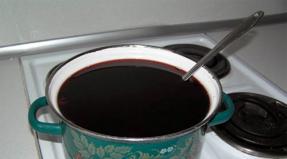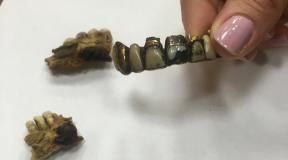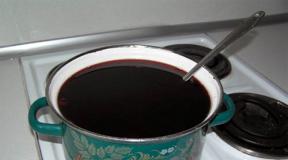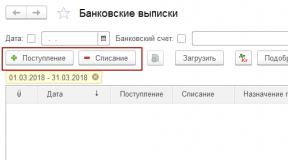Pain in the quadratus lumborum muscle: causes, symptoms, treatment. Quadratus lumborum syndrome Quadratus lumborum muscle aching pain
The quadratus lumbar muscle is a paired muscle, it is attached to the bones in three places: its upper part to the lower - 12th rib, its middle part to the first four lumbar vertebrae, and its lower part to the pelvic bone. Pain in the lumbar region is often associated with excessive tension in this particular muscle. Sometimes great pain appears only on one side - right or left.
hip and sometimes even knee.
With chronic stress, the muscle becomes so overstrained and tired that the pain spreads to the bone structures: the lumbar vertebrae suffer (pain in the spine); pain can also be felt in the pelvic region, moving to the hip joint, spreading along the leg, etc.; the desired muscle can pull up the lower rib, which causes the lumbar deflection to increase, and the pelvic bone goes into an anterior tilt, which gives additional compression to the intervertebral discs, and this threatens further intervertebral hernia.
The most common causes of quadratus muscle spasm are chronic overexertion, as well as excessive uncharacteristic load on an untrained, weakened muscle.
in dynamics - lifting weights in a twisted bend, these can be heavy objects, as well as injuries during sports, for mothers when holding a child with one hand and awkward bending with a turn;
in static conditions – the muscle becomes very tense when a person spends a long time in a sitting position, for example, at a computer, driving a car, in an uncomfortable position, which is why overstrain occurs;
with different leg lengths (due to pathologies of growth and development of the body, or due to injury), an uneven load occurs on the right or left side, it turns out that on the shortened side the lumbar muscle is always in spasm, which gives rise to a number of interrelated tensions.
Symptoms of damage to the quadratus lumbar muscle, in addition to lower back pain, may include pain in the sacrum, groin, upper buttock, iliac crest area, sacroiliac joints,
hip and sometimes even knee.
If the pain intensifies day after day, does not go away after a long rest, bothers you during sleep, there is severe morning stiffness, numbness in the legs or tingling, if the pain is accompanied by dysfunction of the intestines, bladder, and other internal organs, you should treat it with due care. attention.
An experienced osteopath or other specialist in this field will help you find out what was the cause and what was the consequence. Osteopathy is a real help in launching the self-correction mechanism of bone and muscle structures, and interconnected systems of organs and tissues.
Osteopathic and various therapeutic manual techniques are not the only remedy. You can help yourself by doing physical exercise.
The simplest thing is stretching the lower back, tucking the pelvis in a standing position. First, learn how to do it near the wall - press your back so that the distance between your lower back and back is as small as possible, hold for 5-7 minutes, or until the pain eases. Then repeat this therapeutic position as often as possible while standing.
Alternately stretching up the right and left sides of the body - reaching for the hand. The second part of the body relaxes at this time.
If your spine allows it (and there is no herniated disc), twisting is suitable for you.
 Back stretch while standing. Stand with your back to the wall, at a distance of half a meter, turn your torso - the upper part of your body - until your palm touches the wall, you will feel the muscles of your lower back stretch. Repeat the same on the other side.
Back stretch while standing. Stand with your back to the wall, at a distance of half a meter, turn your torso - the upper part of your body - until your palm touches the wall, you will feel the muscles of your lower back stretch. Repeat the same on the other side.
 You can also twist while lying on your back - cross your legs, knee over knee, legs slightly bent, turn your lower body in one direction and the other, then switch legs.
You can also twist while lying on your back - cross your legs, knee over knee, legs slightly bent, turn your lower body in one direction and the other, then switch legs.
Due to the fact that nowadays a sedentary lifestyle is becoming more and more widespread, most people in one way or another have back problems and are bothered by back pain, especially in the lower back. Lower back pain can be caused by poor sitting position, poor posture, low physical activity or other factors, and can be either uncomfortable or quite severe. One of the most common causes of lower back pain is quadratus lumborum syndrome. The quadratus lumborum muscle is located in the lower back. It connects the ribs, spine and pelvic bones and when it contracts too much or too often it causes hip elevation and pain in the back, hips and buttocks. The quadratus lumborum muscle is responsible for trunk bending, torso straightening, and stability of the lower back. Because the quadratus lumborum muscle is part of the muscles responsible for moving the spine, damage to this muscle can lead to limited mobility and pain during various movements.
It is often difficult to determine when a muscle overstrain occurs. Sometimes, the pain can be acute and quite severe, and in such cases the patient notes a clear connection with a specific injury. In other cases, there may be persistent pain for several days, with no external obvious cause. In cases where there is tension in the quadratus lumborum muscle, patients may experience spasms or cramps and, despite the fact that these are unpleasant sensations, they indicate that the body is turning on self-regulatory mechanisms.
As with any muscle injury, when damaged in the quadratus lumborum muscle, inflammation and a feeling of warmth in the muscle area appear. This is explained by the fact that when a muscle is tense, the body responds by increasing blood flow, thereby speeding up the healing process.
Swelling in the muscle area is a sign that there is an accumulation of fluid in the tissues surrounding the muscle, which further exposes the muscle to damage and therefore any muscle damage that is accompanied by swelling requires a careful approach to treatment.
Causes
 Quadratus syndrome can be caused by acute injuries such as heavy lifting or twisting of the torso while lifting. Pain can also occur when the back is in a bent position for a long time (for example, when working in the garden). The cause of the syndrome may also be a difference in limb length (when one leg is shorter than the other), which can be either congenital or acquired. But most often, quadratus muscle syndrome occurs due to prolonged static loads. It is very typical in this case for the development of this syndrome in people who spend most of their time at the computer, since the quadratus lumborum muscle is one of several muscles that are overloaded during normal sitting.
Quadratus syndrome can be caused by acute injuries such as heavy lifting or twisting of the torso while lifting. Pain can also occur when the back is in a bent position for a long time (for example, when working in the garden). The cause of the syndrome may also be a difference in limb length (when one leg is shorter than the other), which can be either congenital or acquired. But most often, quadratus muscle syndrome occurs due to prolonged static loads. It is very typical in this case for the development of this syndrome in people who spend most of their time at the computer, since the quadratus lumborum muscle is one of several muscles that are overloaded during normal sitting.
Symptoms
Pain caused by the quadratus lumborum muscle is usually felt in the area of the iliac crest and sacroiliac joints, as well as deep in the upper buttocks. Pain may also radiate to the lower buttock and greater trochanter area. The pain may intensify after sleep, when the patient gets up and begins to walk. Painful muscle spasm when the body takes a vertical position is characteristic of acute overexertion. In such cases, coughing or sneezing can also be painful, as can turning over in bed while sleeping. Strengthening often occurs in the morning, even with small movements, after tense muscles have been in a contracted state all night. Patients often report that the painful spasm occurred after they got out of the shower and reached for a towel, or when twisting, turning, or bending over something in the kitchen while eating breakfast. A less acute onset, with a gradual increase in pain, occurs in patients who sit for long periods of time at work without getting up or moving around. Postural tightness of the quadratus muscle due to poor sleep position may also be an important factor in exacerbating pain symptoms. Pain associated with quadratus muscle syndrome may also occur in the lower back, hips and buttocks, groin, pelvic area, or lower front thigh.
There are symptoms that may indicate that there is a more serious cause of pain:
- Numbness, tingling in the legs or feet.
- Constant pain that does not improve with rest.
- Gradually increasing pain.
- Bladder or bowel dysfunction.
- Pain that gets worse during sleep.
- Numbness in the perineum.
- Morning stiffness that lasts more than half an hour after getting up.
- Weight loss, night sweats, or fever
If you have such symptoms, you should definitely seek medical help.
Diagnostics
There are a number of medical conditions that can lead to muscle spasms.
Symptoms similar to those of quadratus lumborum syndrome are:
- Trochanteric bursitis
- Root compression at the S1 level
- Intervertebral foramen stenosis
- Lumbosacral radiculitis
- Cauda equina syndrome
- Ankylosing spondylitis
- Arthrosis
- Rheumatoid arthritis
- Weakened abdominal muscles
- Diverticulosis
- Endometriosis
- Uterine fibroids
- Uterine prolapse
- Pelvic inflammatory disease
- Kidney infections
- Urolithiasis disease
- Urinary tract infections
Due to similar symptoms, it is necessary, first of all, to exclude these diseases using instrumental (radiography, MRI or CT, ultrasound of the pelvic organs) and laboratory research methods. After excluding other possible genesis of the pain syndrome, the presence of quadratus muscle syndrome can be assumed. Typically, a physical examination is sufficient to diagnose this syndrome. There is pain on palpation of the affected muscle and increased pain when turning the body and the presence of painful trigger points, especially in the area of attachment to the 12th rib (palpation of this area causes pain in the quadratus muscle). In addition, the presence of lateral paravertebral spasm is characteristic.
Treatment
In cases where there is a clear connection with a certain muscle overload, rest and application of cold to the muscle is sufficient. But often it is necessary to use other treatment methods.
Physiotherapy. Modern physiotherapeutic methods, such as cryotherapy or HILT therapy, help to quickly relieve muscle spasms and muscle inflammation.
Massage and manual therapy allow you to remove muscle blocks and improve blood circulation in the muscle
Exercise therapy. Therapeutic exercise allows you to restore normal muscle tone and muscle elasticity and is especially effective when it comes to the syndrome that occurs due to static loads.
Drug treatment. It is possible to take NSAIDs for a short time.
Trigger point injections are also commonly used to treat quadratus muscle syndrome.
Quadratus lumborum pain is a sensation of discomfort in the muscle tissues located deep in the lower back on either side of the spine.
The quadratus lumborum muscle begins in the pelvis and goes to the lowest rib. It plays an important role in stabilizing the pelvis when the human body is in an upright position.
It also supports the torso during breathing. The quadratus lumborum muscle is one of the main sources of pain in the lower back.
The content of the article:Symptoms
Pain in the quadratus lumborum muscle can become a serious obstacle to daily life activities.Symptoms of quadratus lumborum pain include discomfort and tension in the lower back. The types and degrees of pain may vary.
Low back pain is often described as a deep, aching pain, but it can also be sharp and severe, depending on the individual case.
Although discomfort often bothers a person at rest, it can intensify with activity. Walking, standing, or rolling in bed may aggravate the pain.
Sharp pain may also occur when coughing or sneezing. Pain in the quadratus lumborum muscle can interfere with daily life activities and make a person feel uncomfortable even while walking or sitting.
Such pain can be chronic, that is, it disturbs a person for a long time. In such situations, people almost always notice that pain negatively affects their quality of life and overall well-being, as a result of which their psychological tone also worsens.
According to a study, people who suffer from chronic low back pain are more likely to experience anxiety and depression than those who have never dealt with long-term pain.
Additionally, it should be noted that if one part of the body feels pain, other areas can compensate for the affected area in order to maintain the overall functionality of the body.
For example, if quadratus lumborum pain is severe and painful, it may cause a person to change their gait or posture. Such changes can bring stress to other parts of the body and ultimately cause new lesions.
Trigger points and “lumbago” for lower back pain
 The quadratus lumborum muscle plays an important role in holding the torso upright.
The quadratus lumborum muscle plays an important role in holding the torso upright. A trigger point is a sensitive, vulnerable area of a muscle or associated tissue that causes a person to feel pain when stimulated or pressed. A trigger point is often referred to as a small knot in a muscle fiber.
When a trigger point takes pressure, so-called “shooting” can occur, that is, pain that a person feels in an area of the body that is distant from the stimulated trigger point.
Quadratus lumborum trigger points can cause pain in the lower back, pelvis, and hips.
Why does pain occur in the quadratus lumborum muscle?
There are several potential causes of quadratus lumborum pain. The main ones are given below.
Prolonged sitting
Prolonged sitting causes continuous compression or tightening of the quadratus lumborum muscle. Constant compression leads to muscle fatigue. If blood flow to the muscle is reduced, the person will feel tight and sore.
Poor posture
Poor posture while standing or sitting can cause excessive tension in the quadratus lumborum muscle and lead to pain.
Leaning to one side for long periods of time or sitting without back support can cause muscles to become tight and sore.
Muscle weakness
If the muscles surrounding the quadratus lumborum muscle are weak, it can cause other muscles to work harder than necessary.
If other muscles in the back or pelvis are weak, the quadratus lumborum muscle will be forced to work harder to support the body. Eventually, the psoas muscle becomes overworked and too tight.
Unequal leg length
Legs of unequal length can cause additional stress on various parts of the body, including the quadratus lumborum muscle.
If one leg is shorter than the other, the pelvis may be higher on the side of the longer leg.
A tilted pelvis can cause the quadratus lumborum muscle to contract, causing additional tension.
Injury
Like any other muscle, the quadratus lumborum muscle can be injured. Injuries sustained in car accidents or while playing sports also cause pain.
Daily activities if done incorrectly can also cause injury. For example, lifting heavy objects awkwardly or carrying too much weight can strain the quadratus lumborum muscle and lead to injury.
Treatment
Several methods of therapy will help get rid of pain. In some cases, home treatment may be effective. In more complex situations, discomfort can be reduced by combining home treatment with medication.
Depending on the severity of the pain, the following therapeutic steps may help.
Yoga
 Yoga can relieve quadratus lumborum pain
Yoga can relieve quadratus lumborum pain Yoga is a list of poses and stretches that can reduce quadratus lumborum pain.
Along with improving physiological function, yoga can often help improve emotional well-being, which is very important for people with chronic pain.
Medicines
Various medications, such as muscle relaxants, can effectively reduce pain in the area in question.
Some of these drugs have side effects - drowsiness, dry mouth, fatigue. Therefore, you can purchase them in pharmacies only with a doctor’s prescription.
Trigger point injections
Trigger point injections are a method of delivering medications directly to trigger points to help desensitize them.
In this case, injections of anesthetics can be used to numb the affected areas. In some cases, steroids are administered to reduce inflammation.
Trigger point injections can help reduce muscle spasms and pain in the quadratus lumborum muscle in many cases.
Manual therapy
Massage therapy may be helpful in relieving lower back pain. Massages often reduce muscle tension and increase blood flow to the affected areas.
Warm and cold
Applying ice to the sore area can reduce inflammation, while heat can increase blood flow and reduce pain.
You can try alternating heat and cold to relieve back pain. A warm bath will also not be superfluous in such situations.
Exercises
Certain exercises can help prevent excessive strain on the quadratus lumborum muscle. Some of them are given below.
Raising arms with body tilt
Stand with your feet shoulder-width apart, raise your left arm above your head and lean to the left as far as possible. Hold this position for 20 seconds and then repeat the exercise with the other arm.Tension of the quadratus lumborum muscle in a supine position
Take a lying position on your back. Bend both knees and cross your right leg over your left leg so that your right leg is on top. Allow your weight to lower your legs to the right as quickly as possible. Hold this position for 20 seconds, and then repeat the exercise by changing the position of your legs and the side of their lowering.Prevention
The following steps will help prevent pain or reduce discomfort if pain develops. They can be used by a person no matter what type of pain they are experiencing:
- watch your posture when you sit and when you stand;
- use pillows to support your spine when sitting;
- lift heavy objects with your leg muscles, not your lower back;
- maintain a healthy body weight;
- take frequent breaks to avoid overexertion;
- Try not to sleep on one side of your body.
conclusions
Treatment results for quadratus lumborum muscle pain depend on the severity of the pain. Pain can often be managed successfully, especially if symptoms are treated early. In some cases, treatment may take a long time. However, a combination of the above therapies will result in improvement for most people suffering from low back pain.Quadratus Psoas and Tension Points
QUADRATE LUMBAR MUSCLE- This is one of the muscles that is most often associated with pain in the lower back, in fact, it is more often than others the source of pain. This small muscle is located deep in the lumbar region. Its upper part is attached to the tiny rib XII, located at the very bottom of the rib cage, the side parts are attached to the first four lumbar vertebrae, and the lower part is attached to the top of the pelvic bone.
The quadratus psoas muscle provides stability to the lumbar spine in a standing position. When contracted, it bends the lumbar spine laterally and raises the hips. It also works during breathing: it lowers the chest down when inhaling. The muscle is especially active during intense exhalations or during coughing and sneezing.
Overload often causes tension points to develop in this muscle. When you bend to one side and lift something at the same time, you are most likely to get injured. The same thing can happen when you bend over and twist your body at the same time. Injuries are caused by lifting weights, awkward body positions and car accidents. Running or walking on a road that goes downhill can lead to contraction of the quadratus muscle on one side (the one where the road is higher). The same thing happens to a woman’s body when she prepares food with one hand and holds the baby to her body with the other. (So many mothers do this, including me.) And playing golf, in which the torso alternates between bending and twisting, is a classic example of stress points in the quadratus lumbar muscle.
If there are points of tension in the quadratus muscle, pain is felt in the pelvic area. One group of stress points causes pain in the iliac region and hips, the other in the sacrum and somewhere deep between the buttocks. Pain may also be felt in the groin.
If tension points occur in the quadratus lumbar muscle, the pain can be deep, sharp, and unrelenting. In a standing position, it becomes stronger; the help of hands is already required to get out of bed or from a chair. When bending forward, pain occurs in the lower back. For severe pain, relief can only be brought by pressing the palms inward and downward in the area of the renal pelvis while walking or standing.
In addition to pain in the quadratus muscle, you may find that one leg is shorter than the other. The quadratus muscle is the levator of the thigh. If the muscle is contracted and there are points of tension in it, it pulls the leg up, which is called short leg syndrome. When the muscle relaxes, this defect disappears.
The quadratus muscle is located in the soft tissue between the last rib and the pelvic bones. It can be massaged while standing, but it is best felt while lying down. Lie on the side in which you do not feel pain, place low pillows under your head and side (between the ribs and pelvis). The legs should be positioned so that the knee of the upper leg is behind the knee of the lower leg. Feel the soft spot between the pelvic bone and the lower rib. Then use your thumb to find the top of your pelvic bone. Walk your fingers along it towards the back. This is where you will find the hard tangles of muscle. To find and engage the quadratus muscle, breathe deeply. Now press it towards the spine and from this point walk along the entire muscle up to its connection with the chest. Press directly on tight bands to loosen them. The quadratus muscle may need to be worked on for several days. Stretching, which plays a very important role in relaxation, will help provide relief from pain faster.
Stretch 1: Lie on your back, bend your knees, and place your feet on the floor. Now place the knee joint of the leg in which you do not feel pain on the knee of the painful leg. Press your upper leg onto your lower leg to relieve pain. This will help stretch the muscles where the pain is occurring. If you have pain
 |
Stretch 1 quadratus lumbar muscle |
on the right, place your left foot on top of your right and press towards the left. Maintain this position for 15 - 20 seconds. Stretch several times a day.
Stretch 2: You can also stretch the quadratus muscle while standing. Stand with your back to the wall at a distance of about 30 cm. Turn your upper body and touch your palms to the wall.

Stretch the 2nd quadratus lumbar muscle
If there are stress points in the quadratus muscle, they can also develop in the gluteal muscles (medius and minimus). After the quadratus lumbar, these muscles must also be checked.
 Photo: MedPage Today
Photo: MedPage Today
Symptoms of quadratus lumborum syndrome
Symptoms include tightness and discomfort in the lower back. The pain is often described as a deep aching pain, but it can also feel sharp. Although discomfort may occur at rest, it worsens with movement. Sharp pain may also be felt when sneezing or coughing. Pain in the quadratus lumborum region can interfere with daily activities. People with persistent low back pain may experience anxiety and depression, according to one study. Additionally, if pain occurs in one part of the body, other parts of the body can compensate and support the injured area. For example, if the quadratus lumbar muscle is tight and painful, then the person’s posture may change and he will walk in a forced position. These changes can place stress on other parts of the body, such as the hip joints, which can lead to further injury.
Trigger points- these are sensitive areas in the muscles or connective tissue, when pressure is applied to which pain develops. Trigger points are often called nodules. When trigger points are pressed, radiating pain occurs that is felt in another area of the body. Low back muscle trigger points can cause pain in the lower back, pelvis and hips.
Causes of quadratus lumborum syndrome
There are several possible causes of quadratus lumborum pain:
Long sitting
Sitting for long periods of time causes the psoas muscle to contract, which can lead to muscle fatigue. If blood flow to a muscle is reduced, it can become stiff and painful.
Incorrect posture
Poor posture places additional stress on the quadratus lumborum muscle, which causes pain.
Muscle weakness
When the back and pelvic muscles are weakened, the quadratus lumborum muscle must work harder to support the body. Eventually, the quadratus lumbar muscle becomes overworked and tight.
Different leg lengths
Having different leg sizes can put extra strain on various muscles in the body, including the quadratus lumbar muscle. If one leg is shorter than the other, the pelvis may be higher on the side of the longer leg. A misaligned pelvis can lead to shortening of the quadratus lumborum muscle.
Injury
An injury from a car accident or sports injury can lead to quadratus lumborum pain. Lifting heavy objects improperly can also strain the quadratus lumbar muscle.
Treatment of quadratus lumborum syndrome
In some cases, home treatment can be effective in relieving muscle pain. In other cases, a combination of home care and medical treatments may be necessary to relieve discomfort. Depending on the severity of the pain, the following measures may be helpful.
Yoga
Yoga involves a series of asanas and stretches that can be helpful in reducing quadratus lumborum pain. As well as improving physical function, yoga can improve mental well-being in people with persistent back pain.
Medications
Muscle relaxants and pain medications can reduce quadratus lumborum pain. Some painkillers may have side effects such as drowsiness, dry mouth, and weakness.
Injections
Precision injections involve injecting medications directly into trigger points to reduce pain. An anesthetic may be used for the injection to relieve pain. In some cases, steroid medications are given to reduce inflammation. Injections may be effective in reducing muscle spasm and pain.
Massotherapy
Massage may be helpful in treating soreness in the quadratus lumborum muscle. It reduces muscle tension and increases blood flow to the lumbar region.
Heat or Ice
Applying ice to the lower back area can reduce inflammation, while heat will increase blood flow and reduce pain. You can alternate between heat and ice packs to relieve back pain. A warm bath may also be helpful.
Exercises
In addition, some exercises are useful:
- Standing with your feet shoulder-width apart, extend your left arm up and lean to the left as far as is comfortable. Hold for 20 seconds, then repeat with the other hand.
- Lying on your back, extend your arms to both sides. Bend both knees and place your feet to the right. Hold for 20 seconds, then repeat to the left.
Prevention of quadratus lumborum syndrome
Some simple steps can prevent pain and reduce discomfort.
- Maintain correct posture;
- Use a pillow when sitting;
- When lifting heavy objects, bend your knees;
- Maintain a normal weight;
- Take frequent breaks when sitting;
- Avoid sleeping on only one side.
Literature
Bener A. et al. Psychological factors: anxiety, depression, and somatization symptoms in low back pain patients // Journal of pain research. – 2013. – T. 6. – P. 95.


















